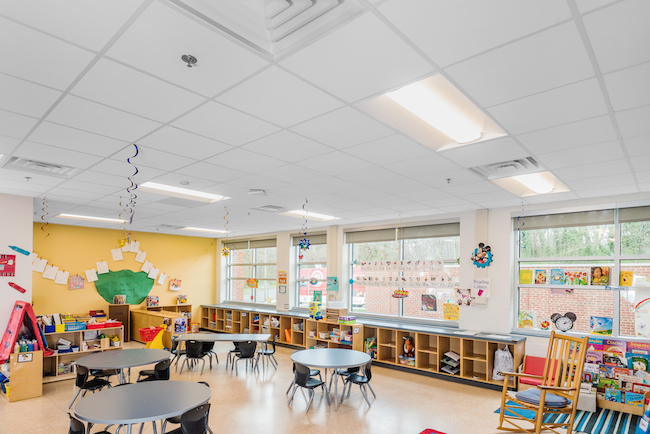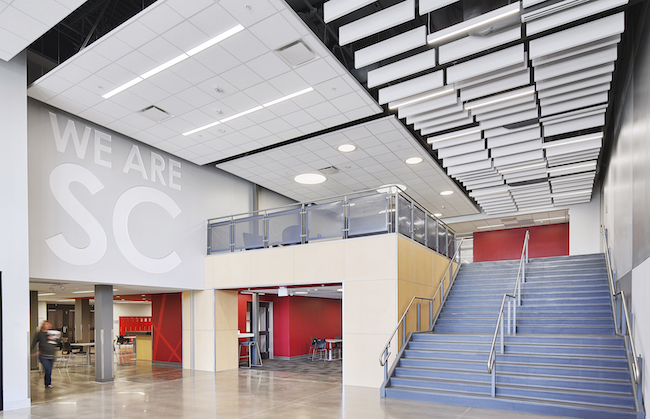How the Right Acoustic Ceiling Can Improve a School's Performance
Go into a classroom and look up. What is seen overhead can be, in large part, determining if students are hearing enough words to understand their lessons, if teachers are taking sick days due to vocal fatigue and consequentially, if administrators are meeting annual operating budgets. These factors relate to the acoustics in the classroom and more specifically, to the sound absorption within it.
If there is not enough sound absorption in spaces for learning, they are overly loud, reverberant and stressful; not an environment conducive for effective education. Up to one of every four words cannot be understood by students in many classrooms, according to guidelines by the Acoustical Society of America.
When the spaces are well-designed acoustically, speech intelligibility increases and the overall noise level decreases. This means that students can understand a higher percentage of spoken words and teachers do not need to strain their voices above high noise levels. These two fundamental improvements then have positive and significant ripple effects through the quality and financial performance of the school.

Walker-Grant Center; Fredericksburg, Virginia.
Credit: OddBox Studios; courtesy of Rockfon
The relationship between acoustics and school performance is so well-established that minimum and enhanced acoustic requirements have been codified in some geographic regions and are included in national standards, guidelines and building rating systems including Green Globes (ANSI/GBI 01-2019), U.S. Green Building Council’s LEED® and the Collaborative for High Performance Schools (CHPS). Both the American Audiology Association and the American Speech Hearing Language Association also have position statements on school acoustics.
Acoustics 101
Sound is a form of energy generated by a vibrating object moving the air molecules around it resulting in outwardly radiating spherical waves. Part of those sound waves travel from the sound source, such as a teacher’s vocal cords, directly to the students’ ears. This is the direct sound, and it is typically the most intelligible because it is the loudest and clearest. Other sound waves do not propagate directly to the intended recipient. Instead, they go off in different directions and reflect off surfaces before being heard. If they reflect around long enough inside the enclosed room, they are known as reverberation.
Reverberation is an ever-present noise that makes it difficult to differentiate words such as fifty and fifteen. To avoid problems associated with excessive reverberation in learning spaces, standards often mandate a maximum reverberation time of 0.60 seconds. The core U.S. standard for classroom acoustics is ANSI/ASA S12.60 Acoustical Performance Criteria, Design Requirements, and Guidelines for Schools. It states that a reverberation time of 0.60 seconds is a minimum performance requirement and that classrooms should be readily adaptable to achieve no greater than 0.30 seconds.
Sound-absorptive materials, such as carpeting, curtains, acoustic wall panels and acoustic ceilings, have porous surfaces and cores. The sound energy can easily penetrate these materials and get converted to heat through friction as the moving air molecules in the sound wave interact with the surfaces of the material fibers. Conversely, sound-reflective materials, such as concrete, glass, metal, drywall, are nonporous, hard, massive, and result in loud, excessive reverberation in enclosed rooms. These sound-reflective materials are very common in schools due to their cost effectiveness, impact-resistance and cleanability.
Acoustic Ceilings
The smart approach to adding sound absorption to learning spaces is an acoustic ceiling system. The contractor first installs a modular, metal, tee-bar, suspension grid. Mechanical and electrical elements, such as lights and air vents, are placed into the grid as are acoustic ceiling panels. This suspended acoustic ceiling also conceals the overhead electrical, fire suppression, structural, heating and air conditioning elements from sight.

Salina Central High School; Salina, Kansas. Credit: Michael Robinson Photography LLC; courtesy of Rockfon
Due to their lower cost and higher durability, sound-reflective concrete, glass, metal and drywall are often used in schools. To control noise levels and increase speech intelligibility, high-performing sound-absorptive ceilings should be included overhead.
No other room surface is as large and exposed to the sound energy reflecting around the room than is the ceiling. This means that the ceiling is a very efficient and effective sound absorber. An acoustic ceiling is also positioned high in the room, out of harm’s way. Because of this, acoustic ceilings can be lightweight and far less costly than other acoustic treatments on walls or floors, which must be replaced more often. In existing schools, low-performing ceiling panels can be upgraded easily and cost-effectively, without disrupting the suspension grid or the mechanical or electrical elements.
According to Mick Willis, CFO for Peoria Public Schools in Illinois, the district replaces nearly 140,000 square feet of acoustic ceiling panels each year; the equivalent of one or two schools. By reducing the need for repair and replacement, the district would save $280,000-$560,000 for every year it extends the lifespan of its ceiling panels. This not only minimizes school facility costs, but also maximizes taxpayers’ dollars and districts’ budgets.
Selecting the Right Ceiling
Some smooth, white, acoustic ceiling panels may look very similar, but they can vary in acoustic performance by as much as 50%. That is the difference between a highly absorptive ceiling and basically a reflective ceiling. Exact specifications are important; do not rely on appearances.
Acoustic ceiling panel performance is characterized by different metrics, but the one most applicable to controlling reverberation in learning spaces is Noise Reduction Coefficient (NRC). It is also the one most used in standards. NRC varies between 0 and 1; the higher the rating the better. Green Globes requires that the NRC of ceilings in classrooms be 0.80 or higher. To achieve the preferred 0.30 second reverberation time requirement in ANSI/S12.60, the acoustic ceiling would need an NRC of 0.90 or higher, assuming there is no other sound absorption on the walls or floors.
Not all ceiling panel materials achieve these high-performance values. Ceiling panels made of stone wool are inherently highly sound-absorptive due to their complex, three-dimensional fiber structure. Because the fibers are spun from inorganic molten basalt, stone wool ceiling panels do not require chemical fire-retardants, biocides, fungicides and antimicrobials like other ceiling panel materials.
Enhancing health benefits beyond acoustics, GREENGUARD® Gold-certified, low-emitting ceiling products also are recognized as supporting indoor air quality by LEED, CHPS and others. Additionally, the ceiling is a no-contact surface. While porous, it is not positioned to transfer pathogens from person to person like carpeting or wall panels.
Next Steps
In existing schools with acoustic ceilings, investigate what ceiling panels have been installed and their NRC ratings. If they are below NRC 0.80, consider upgrading these lower-performing ceiling panels with higher-performing, stone wool panels of NRC 0.80-0.90+. If no acoustic ceiling exists at all, consider whether a whole new system is feasible.
Adding new acoustic ceilings in existing buildings can be challenging to coordinate with fire suppression, air distribution and lighting systems. If difficulty is encountered, consider such options as acoustic baffles and islands that can be suspended overhead to avoid interfering with the existing systems.
For new schools being designed, or even schools that are nearing construction completion but have not purchased ceilings yet, ask about the acoustic ceiling panels’ NRC ratings. If they are lower than 0.80, consider changing them to an NRC of 0.80-0.90 or higher. Higher absorption does not necessarily equate to higher cost. At times, higher absorption can come with a cost savings.
There are professionals that can help. The National Council of Acoustics Consultants offers a searchable directory. Some ceiling manufacturers also have in-house acoustic specialists whose role is to help people understand acoustics and to select the right solutions for the best value.